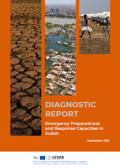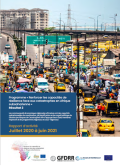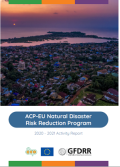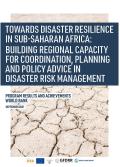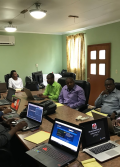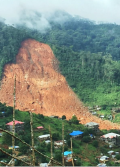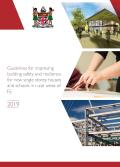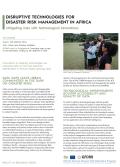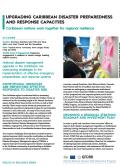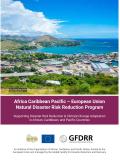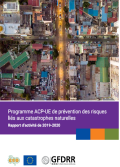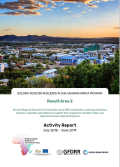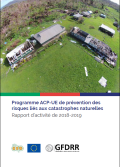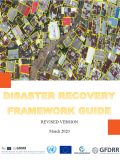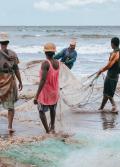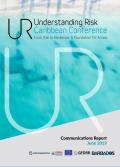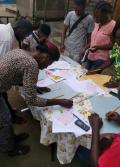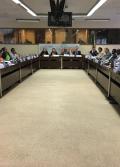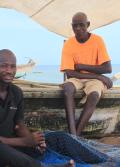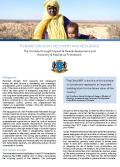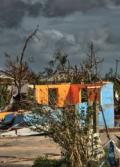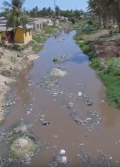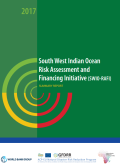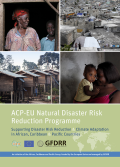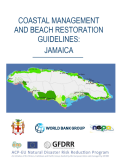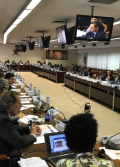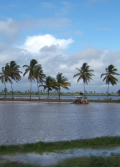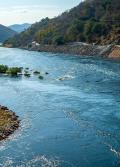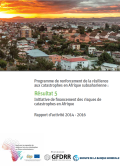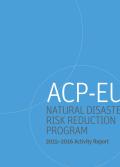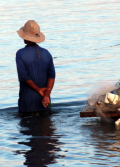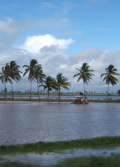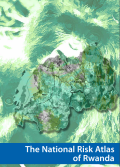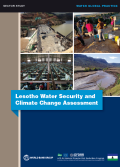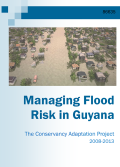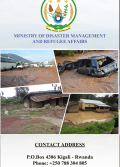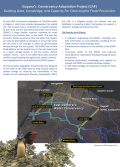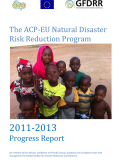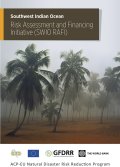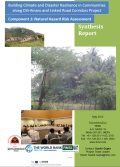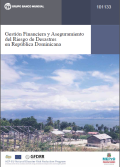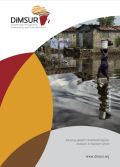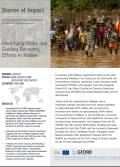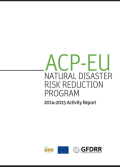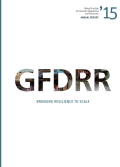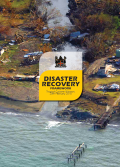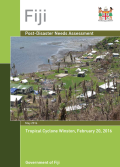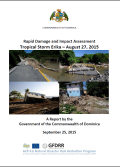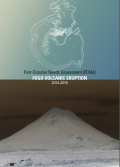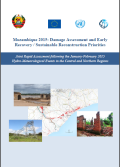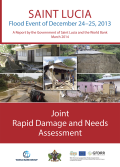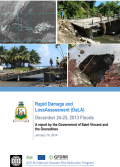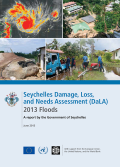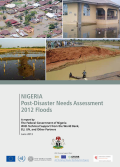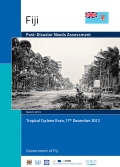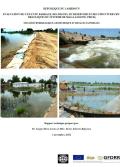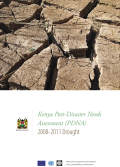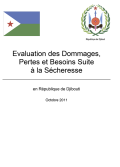ACP-EU NDRR Resources
Sudan Emergency Preparedness and Response Report – 2021
Result Area 2 Program Activity Report 2020-2021
ACP-EU NDRR Program Activity Report 2020-2021
Proceedings of the second ECCAS Hydromet Forum
From May 4-6, 2021, ECCAS, the World Meteorological Organization (WMO), and the World Bank co-organized the second ECCAS Hydromet Forum. This second edition, which was held virtually, aimed to share and consolidate achievements in the field of hydromet services at the regional level. Participants exchanged ideas on modernizing hydromet services in ECCAS member states to better contribute to climate-resilient development and adaptation planning.
Towards Disaster Resilience in Sub-Saharan Africa: Building Regional Capacity, Planning, and Policy Advice, in Disaster Risk Management
ACP-EU NDRR Focus Days – September 2021
The Africa, Caribbean and Pacific Disaster Risk Management (DRM) Focus Days, and final event for the ACP-EU NDRR Program, took place from September 28 to 30, 2021.
The event outlined how the Africa, Caribbean, Pacific-European Union Natural Disaster Risk Reduction (ACP-EU NDRR) Program has helped build resilience to natural hazards across the African, Caribbean and Pacific regions, through regional, country and local-level activities.
Improving the resilience of agro-sylvo-pastoral and fisheries systems in the face of natural disasters in ECCAS member states
Honiara flood risk management study and plan
Result Area 2 - Regional assessment of hazards, vulnerabilities and risks in ECCAS countries
La saison des ouragans est arrivée : Les « Disaster Fighters » forment une équipe, une équipe des Caraïbes.
Result Area 2 - Study on capacity building activities in DRR within ECCAS
Sudan Rapid Post-Disaster Needs and Recovery Assessment
Haiti’s path to building resilience to multiple disaster risks in a fragile context
Informing Resilient Recovery Policy, Planning, and Investments in Freetown, Sierra Leone
The government of Fiji publishes new Guidelines to improve the resilience of homes and schools
Results in Resilience: Disruptive Technologies for Disaster Risk Management in Africa
Results in Resilience: Upgrading Caribbean Disaster Preparedness and Response Capacities
Result Area 2 - Strengthening hydromet services, flood and drought management in Central Africa
Result Area 2 - report on technical and institutional capacities in the field of Disaster Risk Management in Central Africa
ACP-EU NDRR Program Brochure
This brochure provides a global overview of the ACP-EU NDRR Program, its objectives, how it works and where it operates. Highlights include results from the Program’s operations since it was launched in 2011 and its accomplishments in ACP countries. The brochure reflects the participation of the European Union, the Organization of African, Caribbean, and Pacific States, and the Global Facility for Disaster Reduction and Recovery.
Result Area 2 - Activity Report 2019-2020
The FY20 Activity Report for the Result Area 2 Program highlights how despite the COVID-19 pandemic, African Regional Economic Communities have continued providing their respective member states with key technical assistance to improve their human, institutional, and financial resources dedicated to strengthening resilience to disaster risk and climate change.
ACP-EU NDRR Program Activity Report 2019-2020
The FY20 Activity Report of the ACP-EU NDRR Program highlights the continued efforts of ACP countries and regional organizations to integrate resilience to disaster risk and climate change into development planning at local, national and regional levels.
The Open Cities Africa initiative develops critical disaster risk data
2020 International Day for Disaster Reduction - Strengthening disaster risk governance in Africa, the Caribbean, and the Pacific
Results in Resilience: Strengthening Disaster Management Policy in Pacific Island Countries
Facing drought, Covid-19, and hurricane season, Saint Lucia bolsters its disaster risk financing plans
Proceedings of the Understanding Risk West and Central Africa regional conference
Result Area 2 Program - Gender strategies and action plans for disaster risk reduction
Result Area 2 Activity Report 2018-2019
ACP-EU NDRR Program Activity Report 2018-2019
Disaster Recovery Framework Guide
Guidelines for using drones for disaster assessments in the Pacific islands
How Partnership is Powering Progress Towards a Resilient Future in Madagascar
Due to its location, topography, and socioeconomic conditions, Madagascar is one of the most exposed and vulnerable countries in the world to climate change and extreme weather events, with cyclones, flooding, and drought posing the greatest risks. Madagascar and other Indian Ocean countries have recently been affected by Tropical Cyclone Belna in December 2019, which followed tropical cyclones Idai and Kenneth that also hit the same region earlier in 2019.
Africa Disaster Risk Financing Knowledge Exchange at UR West and Central Africa
Recent years have shown the growing demand for support and tremendous drive by Sub-Saharan African countries to work on the Disaster Risk Financing (DRF) agenda.
KNOWLEDGE REPORT FOR THE FOURTH EDITION OF THE WORLD RECONSTRUCTION CONFERENCE
Africa Disaster Risk Financing Initiative: Activity Report 2018-2019
The activity report summarizes activities of Result Area 5, also known as the Africa Disaster Risk Financing (ADRF) Initiative, from July 2018 until June 2019. The report gives an overview of the achievements during this period. So far, the ADRF Initiative has yielded results in supporting governments by strengthening their capacity to design and implement risk financing policies, instruments, and strategies at regional, national and local levels.
Proceedings of the Understanding Risk Caribbean Conference
Results in Resilience: Strengthening Community Resilience in Mozambique
Mali - Rapid Assessment and Disaster Recovery Framework
Results in Resilience: Open Cities Africa
Dominican Republic Risk Profile
Dominica: Results in Resilience - Supporting resilient reconstruction in Dominica following Hurricane Maria
Results in Resilience - Informing Fiscal Resilience Efforts in the Indian Ocean Islands
City planning and community mapping: Gathering people and data in Pointe-Noire, Republic of Congo
Africa Disaster Risk Financing Initiative: Activity Report 2017-2018
Result Area 2 Activity Report 2017-2018
Note on Disaster Risk Management in the Caribbean
Proceedings of the ECCAS Hydromet Forum
ACP-EU NDRR Program: Activity Report 2017-2018
Intra-ACP Focus Day on the ACP-EU NDRR Program
On November 9, 2018, the Secretariat of the African, Caribbean and Pacific (ACP) Group of States and the European Commission hosted the ACP-EU NDRR Program Focus Day in Brussels, Belgium. The theme of the Focus Day was “Mainstreaming Disaster Risk Management (DRM) and Climate Change Adaptation (CCA) in ACP Countries.” The event was organized in the margins of the GFDRR Fall 2018 Consultative Group meeting and Knowledge Partnership Day which took place on 7 and 8 November 2018, also in Brussels, Belgium.
Boosting Investments in Hydromet for Resilient Development Throughout Africa
Fiji and Tonga: Results in Resilience - Using Unmanned Aerial Vehicles to Assess Disaster Risk in Fiji and Tonga
ECOWAS Hydromet Forum and DRR Platform
Solomon Islands: Results in Resilience - Building Community Resilience in the Solomon Islands
Lesotho: Results in Resilience - Strengthening Hydromet Services in Lesotho
Tanzania: Results in Resilience - Improving Risk Information
Fiji: Results in Resilience - Climate Vulnerability Assessment
ACP-EU NDRR Mid-Term Evaluation
The ACP-EU NDRR mid-term evaluation was launched in May 2017, carried out by two independent consultants and completed in June 2018.
Download document in English
Tonga: Post-Disaster Rapid Assessment
Togo: Results in Resilience - Enhancing Disaster Preparedness
Third Edition of the World Reconstruction Conference: Proceedings and Knowledge Report, and Executive Summary
Supporting Road Network Vulnerability Assessments in Pacific Island Countries
Result Area 2: Activity Report 2016-2017
ACP-EU NDRR Program: Activity Report 2016-2017
ACP-EU NDRR Program Brochure
Somalia: Drought Impact and Needs Assessment (Volume III)
Somalia: Drought Impact and Needs Assessment (Volume II)
Somalia Drought Impact and Needs Assessment (DINA) Executive Brief
This document offers a brief overview of the Somalia Drought Impact and Needs Assessment (DINA) and subsequent Resilience and Recovery Framework (RRF), which were requested by the government in August 2017 to identify the root causes of recurrent drought and develop a strategy for medium-term recovery and long-term resilience.
Africa Disaster Risk Financing Initiative: Activity Report 2016-2017
Somalia: Drought Impact and Needs Assessment (Volume I)
Hurricane Irma and Maria Recovery Needs Assessment for Antigua and Barbuda
Urban Flood Risk Management in the Pacific
Fiji: Climate Vulnerability Assessment - Summary Report
Dominica: Post-Disaster Needs Assessment following Hurricane Maria
Sierra Leone: Rapid Damage and Loss Assessment
Fiji: Climate Vulnerability Assessment
Tanzania: Ramani Huria community mapping in Dar es Salaam - video
Southwest Indian Ocean Risk Assessment and Financing Initiative: Summary Report and Risk Profiles
ACP-EU NDRR Program Brochure
Global Facility for Disaster Reduction and Recovery: Annual Report 2017
Jamaica: Coastal Management and Beach Restoration Guidelines
Focus Day on Post-Disaster Response in Brussels
PDNAs and Rapid Assessments
Stories of Impact Series
Result Area 2: Activity Report 2014-2016
Africa Disaster Risk Financing Initiative: Activity Report 2014-2016
ACP-EU NDRR Program: Activity Report 2015-2016
Timor-Leste: Story of Impact - Building Climate and Disaster Resilience in Timor-Leste
Guyana: Story of Impact - Communicating Flood Risk Along Guyana’s Coast
Global Facility for Disaster Reduction and Recovery: Annual Report 2016
Rwanda: National Risk Atlas
Lesotho: Water Security and Climate Change Assessment
Guyana: Report - Managing Flood Risk in Guyana, the Conservancy Adaptation Project 2008-2013
Rwanda: Brochure - Development of Comprehensive Disaster Risk Profiles for enhancing Disaster Management in Rwanda
The Development of (national and local) Comprehensive Disaster Risk Profiles for Enhancing Disaster Management project was launched in October 2012 and closed in April 2016, having successfully completed all key planned activities.




